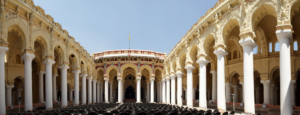Just when the Muslim rulers were trying to impose control over the sovereignty of Madurai, the Nayaks of South India thwarted the advance of Muslim power in TamilNadu. Standing the test of times is the 17th century Thirumalai Nayakkar Mahal in Madurai, one of the most important touring destinations of Tamil Nadu, built by the Nayak rulers, who ruled from 1545 till 1740’s. This magnificent structure, erected in 1636 AD and continued till 1659, was the living palace of the Nayak Kings. The palace was constructed to mark the shift of capital from Trichy to Madurai for the administrative and strategic reason. The design of the palace was made by an Italian architect, and its construction was a confluence of several schools of architecture namely European, Dravidian as well as Islamic types, representing the Saracenic style of architecture.
 It is unfortunate that most original possessions of the Thirumalai Nayak Palace have been either ruined or usurped by its own rulers and what remains today is mostly a mere quarter of its chattels. It was Lord Napier, the governor of Madras (now Chennai) between 1866 and 1872, who restored the entire structure. The Indian Government, post-independence, declared Thirumalai Nayak Palace as a national monument and, to date, continues to be an important historical landmark of Tamilnadu.
It is unfortunate that most original possessions of the Thirumalai Nayak Palace have been either ruined or usurped by its own rulers and what remains today is mostly a mere quarter of its chattels. It was Lord Napier, the governor of Madras (now Chennai) between 1866 and 1872, who restored the entire structure. The Indian Government, post-independence, declared Thirumalai Nayak Palace as a national monument and, to date, continues to be an important historical landmark of Tamilnadu.
With richly ornate exterior as well as the interiors, the palace, which is just 2km away from the Madurai Meenakshi temple, is famous for its “Stuccowork” on its impressive domes and grand arches. There is a wide range of architectural wonders from the imposing pillars to the overall splendid structure. There are totally 248 pillars in this lofty palace each measuring 82 feet high and 19 feet wide. The two main divisions of the palace include Swargavilasa & Rangavilasa. You will be able to find a lot of attractions in these two parts viz. a shrine, royal residence, apartments, royal bandstand, armoury, dancing hall, garden and pond.
On stepping into the palace a large central courtyard, surrounded by a circular garden and circular pillars, welcomes you. The palace’s entire structure is made of foliated brickwork, whilst the glossy and smooth texture of the stucco used shell lime or chunnam. The finial topped and gold covered pavilions on both sides of the courtyard make a beautiful sight. The place has also caught the attention of several renowned filmmakers including Mani Ratnam, who shot several scenes of his film “Iruvar” (1997). You also get to enjoy the enthralling sound and light show, which lasts for about 50 minutes, here – a real treat for history and culture lovers.

